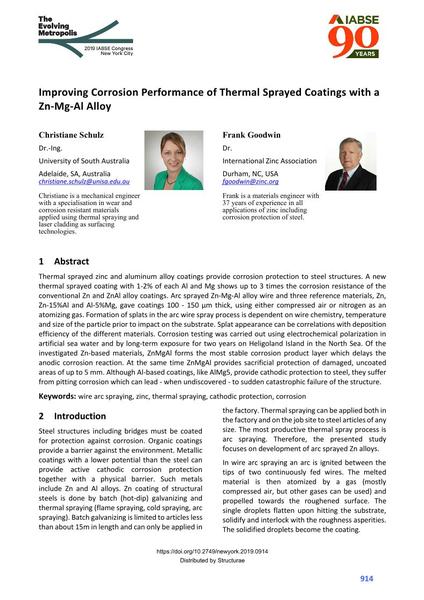Improving Corrosion Performance of Thermal Sprayed Coatings with a Zn-Mg-Al Alloy

|
|
|||||||||||
Détails bibliographiques
| Auteur(s): |
Christiane Schulz
(University of South Australia)
Frank Goodwin (International Zinc Association) |
||||
|---|---|---|---|---|---|
| Médium: | papier de conférence | ||||
| Langue(s): | anglais | ||||
| Conférence: | IABSE Congress: The Evolving Metropolis, New York, NY, USA, 4-6 September 2019 | ||||
| Publié dans: | The Evolving Metropolis | ||||
|
|||||
| Page(s): | 914-919 | ||||
| Nombre total de pages (du PDF): | 6 | ||||
| DOI: | 10.2749/newyork.2019.0914 | ||||
| Abstrait: |
Thermal sprayed zinc and aluminum alloy coatings provide corrosion protection to steel structures. A new thermal sprayed coating with 1-2% of each Al and Mg shows up to 3 times the corrosion resistance of the conventional Zn and ZnAl alloy coatings. Arc sprayed Zn-Mg-Al alloy wire and three reference materials, Zn, Zn-15%Al and Al-5%Mg, gave coatings 100 - 150 µm thick, using either compressed air or nitrogen as an atomizing gas. Formation of splats in the arc wire spray process is dependent on wire chemistry, temperature and size of the particle prior to impact on the substrate. Splat appearance can be correlations with deposition efficiency of the different materials. Corrosion testing was carried out using electrochemical polarization in artificial sea water and by long-term exposure for two years on Heligoland Island in the North Sea. Of the investigated Zn-based materials, ZnMgAl forms the most stable corrosion product layer which delays the anodic corrosion reaction. At the same time ZnMgAl provides sacrificial protection of damaged, uncoated areas of up to 5 mm. Although Al-based coatings, like AlMg5, provide cathodic protection to steel, they suffer from pitting corrosion which can lead - when undiscovered - to sudden catastrophic failure of the structure. |
||||
